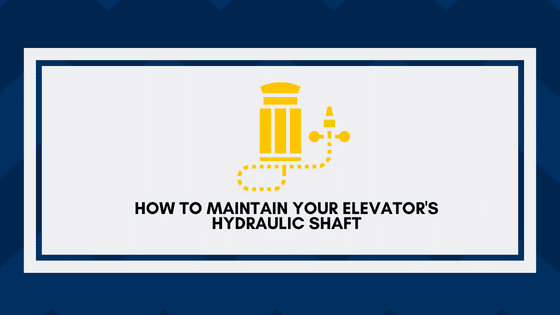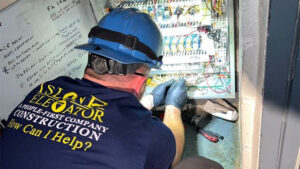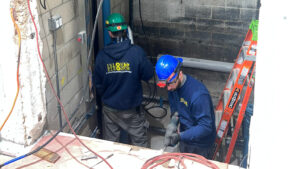
The hydraulic shaft is one of the most important parts of your elevator. Not only does it house the hydraulic fluid that helps power the elevator, but it also helps support the weight of the elevator car.
That’s why it’s so important to keep your hydraulic shaft in good working order. Here are a few tips on how to do just that.

Check the hydraulic fluid level regularly. The hydraulic fluid is what helps power the elevator, so it’s important to make sure that there’s enough fluid in the shaft. You should check the level at least once a week and top off the fluid as needed.
Inspect the seals and gaskets regularly. Over time, seals and gaskets can wear down, allowing hydraulic fluid to leak out. That’s why it’s important to inspect them regularly for wear and tear. If you notice any damage, replace the seals and gaskets as soon as possible.
Keep an eye on the wear plates. The wear plates are what help support the weight of the elevator car. Over time, they can start to wear down and break. If you notice any damage, replace the wear plates as soon as possible.

How Elevator Hydraulic Shafts Work
Most people don’t give much thought to the inner workings of elevators. They just step in, push a button, and wait for the door to close before being whisked up to their destination.
However, there’s a lot going on behind the scenes to make this seemingly magic experience possible. In this blog post, we’ll take a look at how hydraulic elevator shafts work.
Elevator shafts are an important part of any tall building; they provide a space in which the elevator car can travel up and down.
Most elevator shafts are made of concrete, steel, or a combination of both materials. The elevator car is attached to a cable that runs from the top of the shaft all the way down to the bottom.

Hydraulic Oil Shafts
A hydraulic elevator shaft uses a fluid—usually oil—to move the elevator car up and down. A piston is located at the bottom of the elevator shaft, and when fluid is pumped into it, the piston expands, pushing the elevator car up.
When fluid is released from the piston, it contracts, causing the elevator car to descend.
Hydraulic elevators are becoming increasingly popular because they’re much smoother and quieter than other types of elevators.
This makes them more comfortable for passengers to ride in, which is why you’ll often find hydraulic elevators in office buildings and hotels.
Now that you know how hydraulic elevator shafts work, you can appreciate all the engineering that goes into making them function properly!
The next time you step into an elevator, take a moment to think about all of the complex machinery that’s working behind the scenes to ensure you have a safe and smooth ride.

Hydraulic Elevator Shafts – How They Work
Most people have seen a hydraulic elevator shaft, even if they don’t know it. These are the large metal tubes, usually located outside of the building, that the elevator car goes up and down in.
But how do they work? Keep reading to find out!
Hydraulic elevator shafts use a system of pressurized fluids to move the elevator car. The fluid is typically oil, which is stored in a tank outside of the building.
When the call button is pressed, a pump pushes the oil into a cylinder located in the elevator shaft. This increases the pressure in the cylinder, which then pushes the elevator car upwards.
When the elevator reaches the desired floor, a valve is opened to release the pressure and allow the oil to flow back into the tank.
The weight of the car then causes it to descend down the shaft at a controlled speed. If there is a power outage, most hydraulic elevator shafts have an emergency brake that engages to prevent the car from falling down the shaft.

There are two different types of hydraulic elevators
Holed
The holed type of hydraulic elevator has the hydraulic cylinders placed inside of a drilled hole and allows up to 60’ of travel.
Holeless
Holeless hydraulic elevators do not require a drilled hole, making this type of elevator ideal for existing buildings or in areas where drilling would be too difficult or expensive. Hole-less elevators shouldn’t be installed anywhere that requires more than 40’ of travel.
Benefits and drawbacks:
Below is a list of benefits and drawbacks for both types of elevators to give you a better understanding of your options.
Hydraulic Elevators
Benefits:
- Shorter install time frame
- Least expensive to install and maintain
- Capable of moving increased weights (i.e. custom cabs)
- Lower pit and overhead requirements with standard travel
- No crane/roof access required
- Above-ground models available with or without machine rooms (pre-engineered only)
Drawbacks:
- Limited to low and mid-rise buildings
- Machine room required for in-ground applications (viewed as a PRO when service is needed)
- Larger power requirements
- 150 ft./min. max up-speed

Conclusion:
Hydraulic elevator shafts are an interesting example of engineering and physics working together to safely transport people and goods between floors in a building.
Next time you ride in an elevator, take a look at the metal tube it’s traveling up and down in – that’s a hydraulic elevator shaft!

Island Elevator is Ready to Help!
Island Elevator is here to help you understand all facets of your Elevator Repair, Maintenance, & Modernization costs in the new year. Our team is here to help ensure your home and business vertical transportation equipment receive the regularly scheduled maintenance necessary to help you avoid a major catastrophe, reduce the possibility of a costly repair, and ensure the safety of your passengers, tenants, and family.



